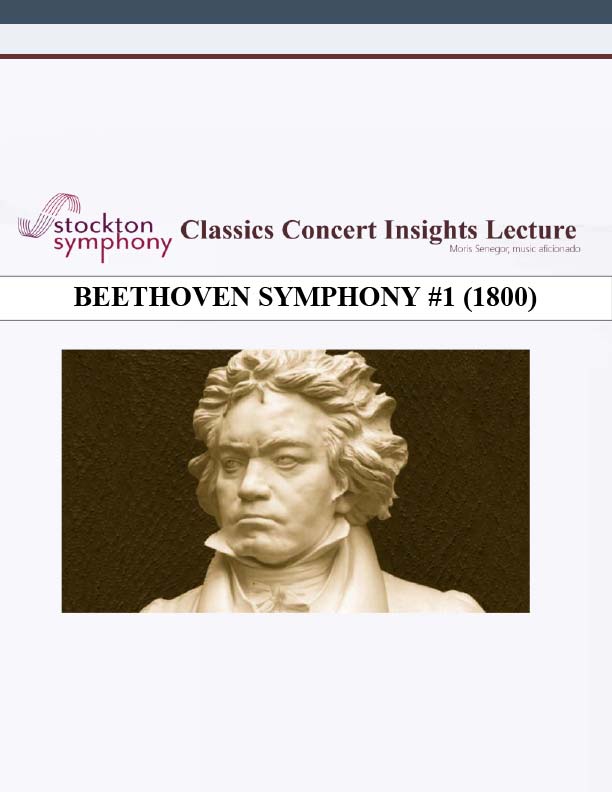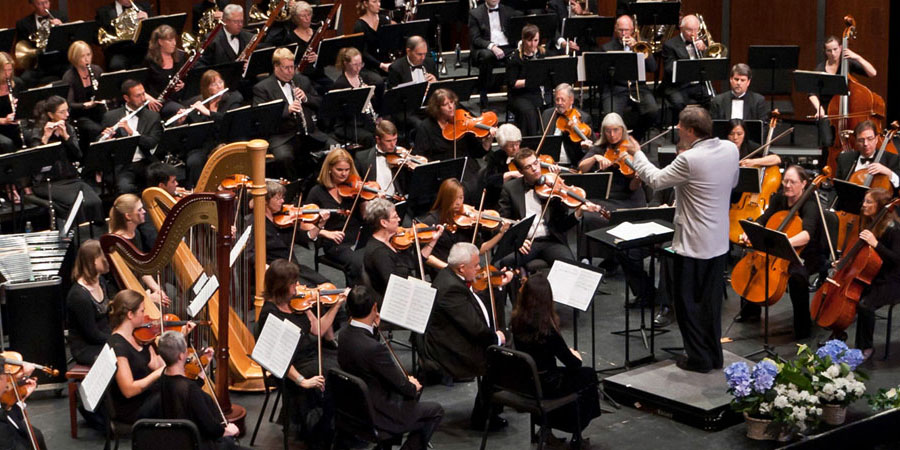
“Beethoven is a bridge between the restrained, aristocratic spirit of Classicism and the fiercely individualistic style of Romanticism.” (Greenberg)
THE VIENNESE CLASSICAL STYLE:
- Clarity of line.
- Form & Proportion.
- Good taste & artistic restraint.
THE CLASSICAL SYMPHONY:
- First movement is Sonata Form, intellectually most challenging.
- Second Movement is an adagio, any form.
- Third Movement is a stylized dance, Minuet & Trio, A-B-A form.
- Fourth Movement, fast and upbeat, Rondo or Sonata form.
BEETHOVEN’S FIRST SYMPHONY:
- 5 years after Haydn’s last symphony (#104, 1795), & 12 years after Mozart’s (#41, “Jupiter”, 1788). Feeling their “hot breath” in this genre, he stayed close to their tradition.
- Still it displays novel and original ideas, especially in the 1st & 3rd movements, already separating himself from the models of Haydn & Mozart.
- In 1800 Beethoven was 29 years old, successful as a concert pianist, financially secure with patrons, commissions and income from his compositions.
- The Symphony, first performed in Vienna, was well received, and much to the composer’s consternation, remained his most popular symphony in Beethoven’s lifetime.
FIRST MOVEMENT: Adagio molto – allegro con brio; C major; 4/4 – 2/2; Sonata form
INTRODUCTION:
- On the surface sounds stately, vaguely aristocratic and Haydn-like.
- Winds play a series of dissonant chords that resolve upwards in different keys, F major, A minor & G major, all “wrong” keys. This creates ambiguity in harmony.
- NOTE: “Dissonance” means a chord that wants to resolve to another, more stable chord.
- Music rises chromatically, strings & bassoons conversing in loud two-note chords that echo the beginning,
- Music finally modulates to C major, the “correct” key, transitioning into Theme I.
- NOTE: By beginning in the wrong key and on a dissonance, and creating an impression that the music is searching for the correct one, Beethoven starts off on a joke. Some contemporaries found this offensive and in poor taste, others viewed it as a new narrative device. In fact, it had been done by preceding composers, but not in a symphony.
- “It is an example of what Beethoven could learn from Haydn’s scores, but something one cannot imagine Haydn teaching in a lesson.” (Steinberg)
EXPOSITION:
- Theme I (C major) is a fast, spirited exchange between strings and winds, rising as it leads to the bridge.
- The string melody of Theme I is derived from the C major triad, and its repetition firmly establishes the home key. The rising chromatic idea in the winds is derived from the introduction.
- Modulating bridge, loud, tutti, fast, features the two-note idea of the introduction.
- Theme II (G major) is a rustic call on the winds echoed by strings, followed by a counter-melody in stings answered by the winds.
- Closing section recalls both themes, followed by transitional music.
EXPOSITION REPEAT:
- The exposition is now repeated verbatim. This was customary in the Classical Era.
DEVELOPMENT:
- Comparatively brief, as it usually is in Classical Era symphonies.
- This is all about Theme I. “Stays close to the cuff” (Greenberg). This restraint in expression is also typical of the Classical style.
- It is at first developed quietly as a conversation between strings and winds.
- A contrapuntal passage follows, again developing Theme I with strings and winds.
- Music rises and transitions into recap.
RECAPITULATION:
- Theme I returns in loud and tutti, last phrase altered and extended. The extension is related to the Introduction.
- Bridge music (no longer modulating and shorter than Exposition) leads into Theme II in C major.
- Closing music follows, same as Exposition.
CODA:
- Recalls Theme I motives and ends with loud, concluding C major chords.
SECOND MOVEMENT: Andante cantabile con moto; F major; 3/8; Sonata form
EXPOSITION:
- Theme I (F major) begins as a fugato, 4-parts, imitative entrances proceeding from high strings to low. It is a quiet, noble melody, reminiscent of courtly dance, with a distinct dotted rhythm, legato-staccato-staccato. The polyphony soon ceases as the theme progresses to an open end .
- Theme II (C major) is closely related to Theme I, but with its own legato-staccato rhythm, and a more distinct four-square-melody.
- Closing section begins with a conversation between winds and strings featuring a staccato-legato, two-note question in winds, to which strings loudly respond with a four note, similarly dotted pattern. Winds continue with two note sighs derived from the Adagio introduction of the first movement. A “lightly tripping” melody (Apthorp) of fast triplets in violins and flute follow.
- A tiny codetta ends the exposition.
EXPOSITION REPEAT:
DEVELOPMENT:
- Brief and low in drama.
- The two note idea that began Theme I goes through various keys and instrument groups in a march like, slow passage , loudly echoing in winds.
- Music rises to loud tutti chords, with quiet wind passages alternating.
- Transitional music alternating between strings and winds ushers recap.
RECAPITULATION:
- Theme I re-enters with a fugal treatment, but now the polyphony is more complex, a counter-melody in running figures in steady accompaniment. The remainder of the theme is more ornamented than in Exposition, and the countermelody continues.
- Theme II returns in F major.
- Closing music returns.
CODA:
- Theme I is subjected to what amounts to another, brief development.
- Two note, legato-staccato theme idea recalled.
- Movement ends quietly with concluding chords
THIRD MOVEMENT: Menuetto: Allegro molto e vivace; C major; ¾; A – B – A form
Even though Beethoven labeled this a “minuet”, a triple meter dance with moderate tempo from the court of Louis IV, most scholars agree that this is, in fact a Scherzo. If not, it is at least a close precursor. Beethoven would not begin using this term, which means “joke” in Italian, until his Second Symphony onwards.
A: MINUET
- In three sections, the first quiet, the others louder.
- First section: a-a-b. Outlines the main themes.
- “a” is too fast and impossible to dance to. It sounds nothing like a minuet.
- “Your tongue would cramp, your arm would fall off if you tried to count or beat one-two-three to each measure.” (Steinberg)
- “a” is derived from the two note idea of the First Movement introduction, with the dotted rhythm in reverse (staccato-legato), and much faster.
- “b” is a countermelody, also fast, and filled with dotted rhythms.
- Transitional music.
- Second section: a – a’ – b.
- It begins with a louder, more assertive version of “a”.
- A new passage (a’) extends “a”; heavily syncopated with emphasis on the second beat.
- “b” follows, repeated verbatim. Transitional music.
- Third section: a – a’.
- Another forceful, tutti version of “a”, followed by the syncopated extension. Ends in a closed cadence.
B: TRIO
- Lowly instrumented, as expected, and initially quieter. Also in three sections.
- First section: a – a – a’.
- “a” is a chorale-like, dotted rhythm melody, closely related to the Minuet theme, played by winds, with a scurrying accompaniment in strings.
- a’ is a transitional, anticipatory section, reminiscent of Movement 1 introduction in its repeated “two-note & pause” profile.
- Second section: a’’ – a’.
- a’’ begins with a dramatic crescendo and presents a loud, tutti, syncopated variation of a, the main trio theme.
- a’ follows as before, repeated two-note ideas with pauses.
- Third section: a’’ only.
A: MINUET
- Repeated verbatim.
FOURTH MOVEMENT: Adagio – Allegro molto e vivace; C major; 2/4; Sonata/Rondo form
INTRODUCTION:
- A musical joke.
- A loud G is held by the full orchestra, provoking anticipation of lofty material to follow.
- Instead we hear quiet, hesitant, mousy music, rising string scales, five in total, progressing one more note each time, with pauses between. It is as though inexperienced musicians are searching for the music.
- Finally, a cheerful, energetic Theme I emerges.
- “Haydn would have appreciated the joke to the full, being much given to such musical pranks himself.” (Hopkins)
- “Beethoven is playing a game of peek-a-boo.” (Greenberg).
- Some conductors omitted this introduction because it made audiences laugh.
EXPOSITION:
- A four-square Hydenesque melody (C major), in three phrases: a – b – b’, “a” stated softly , “b’” featuring a dramatic crescendo.
- NOTE: For those who view the movement as a Rondo, this is the main theme.
- Modulating bridge continues loud and fast, made of falling scales, inversions of the introductory rising scales.
- Theme II (G major) is a dance-like tune, still spirited and cheerful.
- Closing Section features begins with a fast, syncopated conversation between horns and strings. Followed by loud, sequenced scales, also derived from the introduction.
- Exposition ends loud on an open cadence.
EXPOSITION REPEAT:
DEVELOPMENT:
- In a passage reminiscent of the mousy introduction, the music explores the closing material that just preceded it.
- A loud, complex passage follows, with descending arpeggios in strings accompanied by tremolos in other strings.
- Another quiet passage develops Theme I motive.
- Louder music at first continues to develop Theme I. A series of massive ascending scales followed by fervent, repeated G chords lead to transition into recap.
RECAPITULATION:
- Theme I returns (C major) with its last phrase extended as a shorter substitute to what was the modulating bridge in the Exposition.
- Theme II returns (C major) much the same, followed by the Closing Music also much the same until its very end where huge tutti repeated fanfares portend an important event.
CODA:
- Once again, the joke is upon us: mousy music follows, soon leading to restatement of Theme I (C major).
- It is this restatement that has led some to interpret the movement as Rondo form.
- Quieter music with rising scales and cadential chords leads to a loud and dramatic conclusion.
CONCLUSIONS: Classical or Not?
- Aside from the First Movement introduction with is unconventional harmonies, and Third Movement Menuetto which is really a Scherzo, the symphony adheres to the rules and aesthetic of the Classical Era.
- Beethoven’s First Symphony sounds “Classical” to our 21st century ears, since we are familiar with all that followed in the Romantic Era of the 19th century and numerous styles of the 20th. In its own time however, this composition did NOT sound “Classical” to his contemporaries.
- “(Beethoven’s First Symphony) ..was “the confused explosions of the outrageous effrontery of a young man.” (Downes, quoting a contemporary critic)
- “(Beethoven’s First Symphony) wears an eighteenth century periwig; it speaks the courtly language and behaves with the restraint expected of a well-bred symphony. ….But Beethoven’s contemporaries were not deceived. The conservatives smelled a revolutionist. They were rightly alarmed.” (Downs)
- “This is Beethoven’s fitting farewell to the 18th” (Tovey)
Nonetheless, Beethoven’s First remained his most popular symphony in his own lifetime, leading a Parisian critic to comment, ten years after its premiere, that its “astonishing success” was “a danger to musical art.” (Downs)


